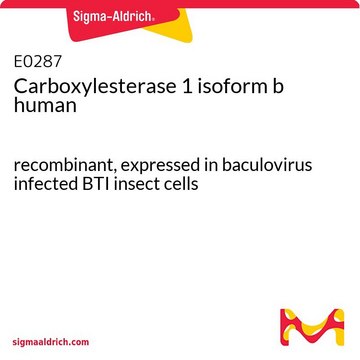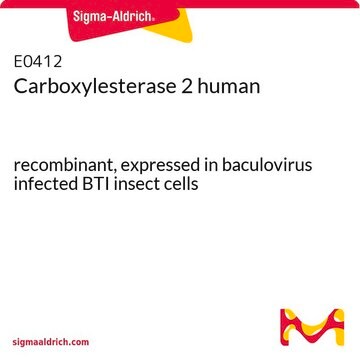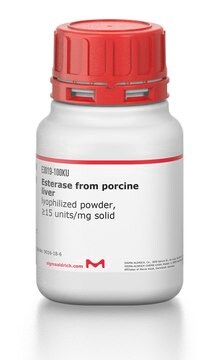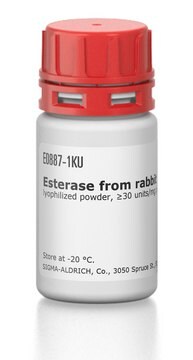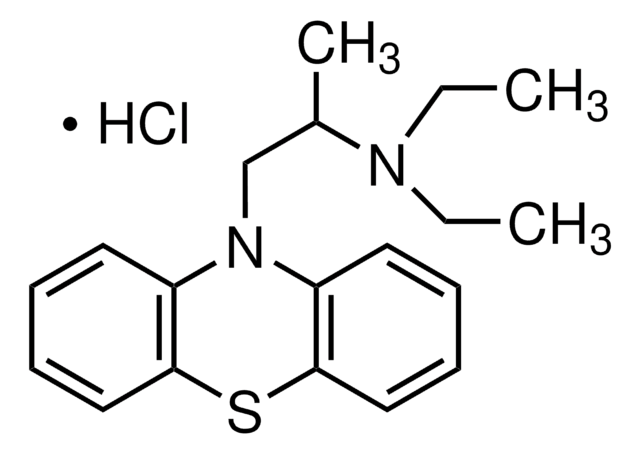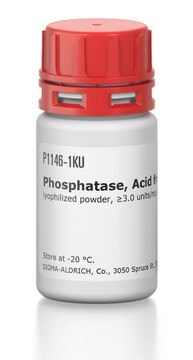E0162
Carboxylesterase 1 isoform c human
recombinant, expressed in baculovirus infected BTI insect cells
Sinónimos:
Carboxylesterase 1 human, carboxylesterase, esterase
Iniciar sesiónpara Ver la Fijación de precios por contrato y de la organización
About This Item
Productos recomendados
recombinante
expressed in baculovirus infected BTI insect cells
Nivel de calidad
Formulario
liquid
concentración
≥0.3 mg/mL
Condiciones de envío
dry ice
temp. de almacenamiento
−70°C
¿Está buscando productos similares? Visita Guía de comparación de productos
Descripción general
Carboxylesterase 1 (CE1) is a member of a large multigene carboxylesterase α,β-hydrolase family. It is majorly expressed in the liver. CE1 comprises an αβ domain, a central catalytic domain and a regulatory domain.
Aplicación
Carboxylesterase 1 isoform c human has been used as a reference standard in carboxylesterase activity from the mussel for comparison of substrate specificity and inhibition studies. It has also been used as a commercial recombinant protein for the methodological validation of environmental chemical-based inhibition studies.
Acciones bioquímicas o fisiológicas
Carboxylesterase enzymes are responsible for the hydrolysis of ester- and amide-bond-containing drugs such as cocaine and heroin. They also hydrolyze long-chain fatty acid esters and thioesters. Carboxylesterase 1 (CE1) catalyzes the formation of cholesteryl esters from cholesterol and fatty acids. Through a transesterification reaction, CE1 also mediates the generation of fatty acid ethyl esters (FAEEs). It also hydrolyzes aromatic and aliphatic esters with preference to small alcohol groups and bulky acyl groups. CE1 metabolizes drug esters and amides carbamates. It participates in the detoxification of environmental toxicants and carcinogens and is useful in pharmacokinetic studies for evaluating pro-drugs.
Propiedades físicas
This product is offered in a volume of 0.5 mL.
Definición de unidad
One unit will hydrolyze one nanomole of 4-nitrophenyl acetate per minute at pH 7.4 at 37 °C.
Palabra de señalización
Danger
Frases de peligro
Consejos de prudencia
Clasificaciones de peligro
Resp. Sens. 1
Código de clase de almacenamiento
11 - Combustible Solids
Clase de riesgo para el agua (WGK)
WGK 1
Punto de inflamabilidad (°F)
Not applicable
Punto de inflamabilidad (°C)
Not applicable
Elija entre una de las versiones más recientes:
¿Ya tiene este producto?
Encuentre la documentación para los productos que ha comprado recientemente en la Biblioteca de documentos.
Los clientes también vieron
Montserrat Solé et al.
Environmental toxicology and pharmacology, 82, 103561-103561 (2020-12-12)
Carboxylesterases (CEs) are key enzymes which catalyse the hydrolysis reactions of multiple xenobiotics and endogenous ester moieties. Given their growing interest in the context of marine pollution and biomonitoring, this study focused on the in vitro sensitivity of marine invertebrate
Jihong Lian et al.
Protein & cell, 9(2), 178-195 (2017-07-06)
Mammalian carboxylesterases hydrolyze a wide range of xenobiotic and endogenous compounds, including lipid esters. Physiological functions of carboxylesterases in lipid metabolism and energy homeostasis in vivo have been demonstrated by genetic manipulations and chemical inhibition in mice, and in vitro
Masakiyo Hosokawa
Molecules (Basel, Switzerland), 13(2), 412-431 (2008-02-29)
Mammalian carboxylesterases (CESs) comprise a multigene family whose gene products play important roles in biotransformation of ester- or amide-type prodrugs. They are members of an alpha,beta-hydrolase-fold family and are found in various mammals. It has been suggested that CESs can
Dandan Wang et al.
Acta pharmaceutica Sinica. B, 8(5), 699-712 (2018-09-25)
Mammalian carboxylesterases (CEs) are key enzymes from the serine hydrolase superfamily. In the human body, two predominant carboxylesterases (CES1 and CES2) have been identified and extensively studied over the past decade. These two enzymes play crucial roles in the metabolism
B Sànchez-Nogué et al.
Environmental science and pollution research international, 20(5), 3480-3488 (2012-12-06)
The common sole, Solea solea (Linneus, 1758), and the Senegalese sole, Solea senegalensis (Kaup, 1858), are two important commercial species that coexist in the NW Mediterranean. In order to assess the species' ability to respond to chemical insults, a comparison
Nuestro equipo de científicos tiene experiencia en todas las áreas de investigación: Ciencias de la vida, Ciencia de los materiales, Síntesis química, Cromatografía, Analítica y muchas otras.
Póngase en contacto con el Servicio técnico